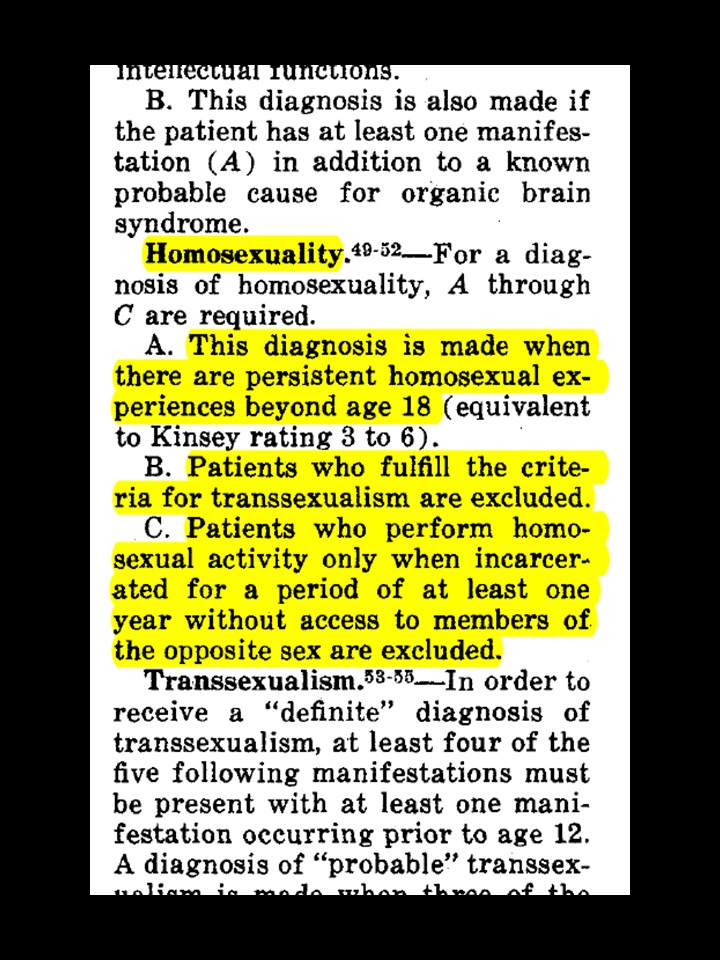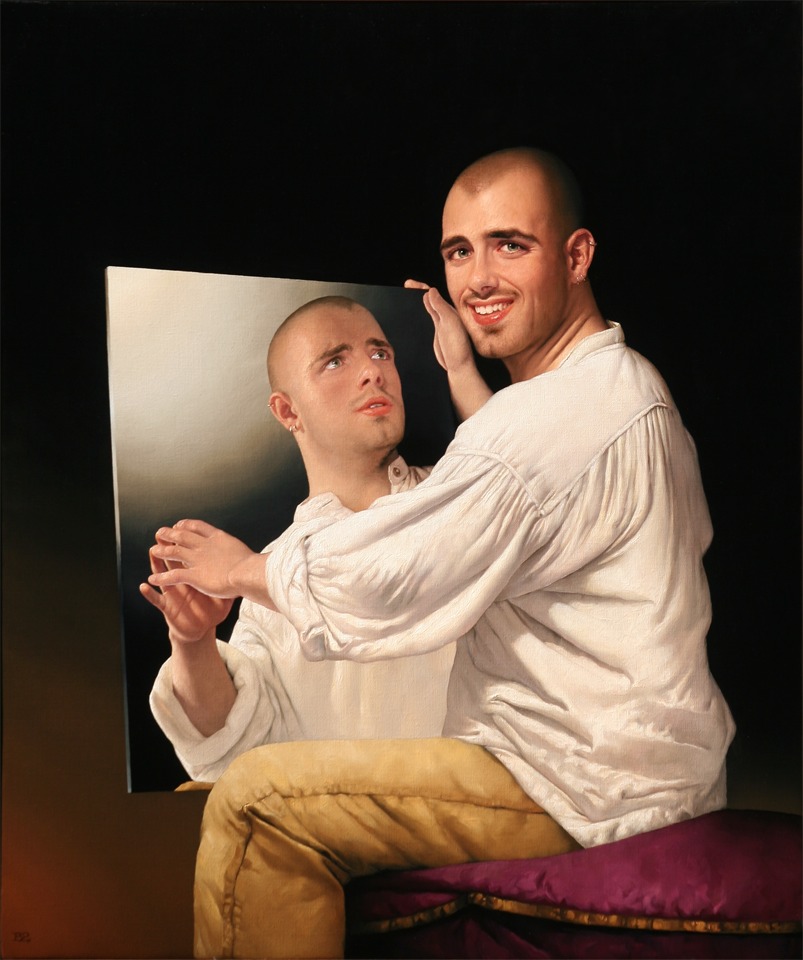By Edgar Rodríguez Sánchez
It’s 2015. Lesbians, gay men, and a growing group of allies commemorate and celebrate 42 years of a freer sexuality. This hasn’t been always this way, however.

As an object of historical, scientific, and cultural interest, in the image above (an extract from the archives of general psychiatry) you can read the diagnostic criteria for use in psychiatric research regarding homosexuality. It was 1972, the Diagnostic and Statistical Manual of Mental Disorders, then in its 2nd edition, still classified homosexuality as a mental disorder.
Over four decades, contemporary psychology has defined homosexuality in terms of the behaviour, attraction, relationships, and the sex of the person that someone has as their object of desire. Although the understanding of homosexuality has become more complex, it is still professional mental health associations the ones in charge of establishing what it means to be homosexual.
Fortunately, many of us, people who identify ourselves as gay, have abandoned the label “homosexual” long, long, long ago. And some others have even abandoned or refused to use the word gay or any other, because we believe it is us who should say who we are, not an association of professionals.
In spite of the empowerment we’ve gained to define ourselves, some still use the term “sexual orientation”. I used to say “my sexual orientation is gay”. But to know ‘who’s gay and who’s not’, researchers try to answer the question by focusing, normally, on a single component of sexual orientation at one point in time. For example, if the person has same-sex relationships or if they identify themselves as gay. Although common, this strategy might not contemplate same-sex oriented individuals who, perhaps haven’t engaged in sexual relationships yet, and includes some people who have same-sex sexual relationships but identify themselves as heterosexuals.
I can see the research community has started to appreciate a more complex way of understanding what is to be gay. However, most professionals still call “sexual orientation” to the erotic and romantic attractions people feel for people of a particular gender. This professional knowledge has dominated the field, to the point that the term eventually permeated the general public and more and more people believe that being gay is a “sexual orientation”. I want to challenge that assumption. How could we pack all the meanings that being gay has for gay people in the term “sexual orientation”?
I argue that the term “sexual orientation” lacks contents to describe what “being gay” means. “Sexual orientation” reduces a number of elements which are part of people’s subjectivities to a sexual aspect. I think of “identities” instead.
Identities are defined by multiple elements, one of those is the interaction with other individuals who serve as points of comparison to appreciate, assess, and value aspects of the own self. The presence of other people who share with us a common history serves as an element to validate our past, and furthermore, their presence corroborates our identity. Identity encompasses a series of aspects, a hundred of different things completely unrelated to to sexual activity. Being gay can mean having had to leave home, it can mean a history of hiding lovers and partners, it can mean having to come out several times, it can mean having strengthen a relationship with mum and dad, it can mean a sense of pride for having symbolically defied the world and having won.
Just to bring two examples of the aspects the term “gay” can encompass, I will say that “being gay” can be seen from a collective perspective and also from an intimate perspective. For some people, being gay might involve a shared perception of being part of the same group; a process of “identification” with others who are “like us”. Identification describes a process which justifies certain attachments to a group; it can touch upon language, cultural expressions, behaviours, geography, and a number of elements that can constitute a collective identity. Although I acknowledge gay men are not a homogeneous group, needless to say the so called LGBT population, I think the idea of a collective identity helps us for political purposes. For instance, when different countries have fought for marriage equality, this collective identity serves to present ourselves to the rest of the world and say “this is us, fighting for what is important for our cause”. It doesn’t mean we’re homogeneous, but it means we are connected and can carry the same flag.
Besides this sense of belonging to a broader culture, which is more important is that, by thinking of identity instead of sexual orientation, we make room for subjectivity and diversity. I refer here to an intimate identity, to a very personal one which is inaccessible to everyone else. This argument would bring me to talk about “identities”, rather than of a single “identity” or a master theory that groups individuals in the same category.

Since I became interested in this theme 15 years ago, I have talked with many people about this topic and the ways in which they experience and narrate what being gay means to them. Those meanings are way far from definitions given by text books and psychiatric manuals. One of the privileges I have as a researcher on identity is that, while listening to people I’ve also seen myself reflected in their stories. Some of the people I’ve talked to have passed by very briefly; an interview, a conversation, a talk in a conference, a random encounter, but although ephemeral exchanges, I’ve learnt from them that they (we) must be the ones in charge of defining what being gay means to them (us). And then professional associations can listen to what they (we) have to say and engage in a dialogue to foster understanding.
The meanings people give to being gay have been coloured, I am happy to say, not only by the traditional colours of the rainbow, but also by black, brown, blue, grey, olive, hazel, and green colours. Colours I have seen in the eyes of the men who have struggled, but also come to terms with their identities; just like ‘the unfinished man’ W. B. Yeats talked about in his poem ‘dialogue of self and soul’. “The unfinished man and his pain, brought face to face with his own clumsiness”.
These gay men I’ve talked to during my research inquiries, have understood, or are trying to understand, the social and cultural aspects of this collective identity but also in their private worlds. This understanding of their inner worlds, from what I’ve seen, is always a process, sometimes painful, sometimes not so much, sometimes not at all.

Recommended readings:
Feighner, J. P., et al. (1972). “Diagnostic criteria for use in psychiatric research.” Archives of General Psychiatry 26(1): 57-63.
Gray, A. and S. Desmarais (2014). “Not all one and the same: Sexual identity, activism, and collective self-esteem.” Canadian Journal of Human Sexuality 23(2): 116-122.
Savin-Williams, R. C. (2009). How Many Gays Are There? It Depends. Contemporary perspectives on lesbian, gay, and bisexual identities [electronic resource]. D. A. Hope. New York, Springer. 54: 5-42.
Yuval-Davis, N. (2011). The politics of belonging : intersectional contestations. London, Los Angeles: Sage Publications.
